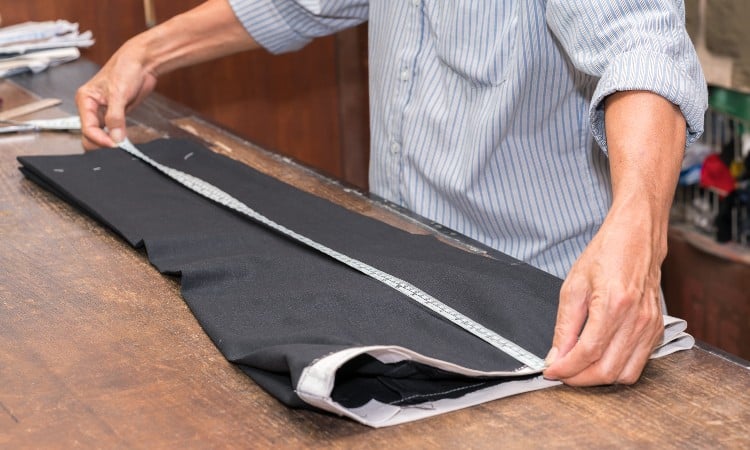When you need to buy pants, you may be overwhelmed by the measurement terms that get flung around, such as inseam and outseam, rise, and waist. While this can seem confusing, learning to take your own measurements for pants and shorts will help you buy clothes that fit you perfectly! The good news is that you can follow this easy guide to learn how to measure outseam.
The best way to measure outseam length is to measure the distance from the side of the waist to the lower edge of the ankle on the outside of the leg. Measuring a pair of pants from the top edge of the waistband, down the external side seam, and to the bottom edge of the cuff will also provide an accurate outseam length. Both men’s and women’s clothing, such as pants and shorts, have an outseam.
In this article, you will learn how to measure your own outseam length. You will discover how inseam and outseam lengths work together. Finally, you will find out how to measure the outseam for shorts, pants, and tuxedos.
Quick Navigation
What is an Outseam Measurement?

An outseam measurement describes the distance from the waist to the foot or ankle on the outer side of the leg. It also describes the outer side seam of a pair of pants or shorts, in contrast to the inner side seam that runs up the inside of your legs.
The outseam measurement offers crucial information that can help you pinpoint the shape and size of pants or shorts that fit your body best.
Unfortunately, many mainstream clothing manufacturers do not use the outseam as one of the key measurements you can choose in a clothing size chart. This is because modern manufacturers found that offering three variables in pants measurements–inseam, waist, and outseam–forced the brands to make too many different shapes and sizes of pants.
Because of this, many big-name brands offer clothes with only two measurement options–the waist circumference and the inseam, or length. This is why you see men’s jeans sizes like 32X34, meaning a 32-inch waist and a 36-inch inseam.
High-end clothing brands, in contrast, still offer variation based on the outseam because they realize that an inseam measurement is not enough to accurately describe the shape of a pair of pants. Think about it this way: the outseam on a pair of skinny jeans will have a much shorter length than the outseam on a pair of loose “dad style” slacks because the slacks have more body.
The huge range of differences in outseam based on the pants style makes this a very important measurement to know as you shop for pants.
On top of this, for slacks, dress pants, and other more formal attire, the outseam will differ depending on the kind of break the trousers have. The break describes where the hem of the pant ends in relation to the foot or shoes. For example, a full break means that the hem gently folds over onto the top of the shoe, but you can also have a half break, quarter break, or even no break!
If you want a specific break for the hem of your pants, you will need to adjust your outseam measurement accordingly.
How to Measure Outseam: 3 Methods

Follow these steps to take your own outseam measurement for both men and women or learn how to measure a pair of pants to get its precise outseam measurement.
1. Men’s Outseam Measurement
You can easily take your own outseam measurement for men’s clothing using a flexible tape measure. To get an accurate measurement, you will need a friend or helper with a second pair of hands.
- Stand with your back to a wall to ensure good posture. Make sure you have on a pair of pants that fits you well and wear the kind of shoes you will wear with the pants you want to purchase. For example, if you need to buy a tuxedo, wear your dress shoes in case the heels are a different height from your sneakers.
- Have your friend place the short end of the tape at your hip or the point where the waist on your current pair of pants starts, but at the external side seam.
- Next, your friend will use the tape to trace down the side seam in the pants that runs down the outer edge of your leg.
- Stop at the point where your shoe meets your foot.
- Note down this measurement, and add one inch to it. You have a classic outseam measurement for yourself!
For slacks, trousers, or dress pants, you may also want to try this tailor-approved variation. You will need someone else to help you with this method as well.
- Take your shoes off, but you can wear your socks. Make sure you wear a pair of pants with a waist that fits you the way you like.
- Stand with your feet slightly apart and flat on the floor.
- As you do this, your helper will put the end of a flexible tape measure at the center of your pant waistband.
- While holding that end of the tape in place with one hand, the helper will allow the remainder of the tape to fall straight down to the floor.
- Note the measurement where the tape touches the floor. Also, remember that the tape needs to fall in a straight line–you do not mold it to the back of your legs for this technique.
- Finally, use these tips to get the correct trouser break with your outseam measurement: for a full break, do not add or subtract anything. For a half break, take away one inch of the measurement. For a quarter break, subtract one and a half inches; for no break at all, subtract a full two inches from the measurement.
2. Women’s Outseam Measurement
Measuring your outseam length for women’s clothing requires a few simple steps and a tape measure, but this process also goes better with a helper. This is because you have to measure down to your ankle for this process, and you would have to bend over to reach your ankle on your own. This would skew your results.
- Stand with good posture and relaxed shoulders, keeping your feet hip distance apart.
- Help your friend locate the top curve of your hipbone. Use a tape measure to find a point exactly one inch below this top curve. Use one of your hands to hold the end of the tape in place there.
- Next, ask your friend to trace the tape down the side of your leg.
- Finally, your friend will locate the bony ridge of your ankle bone and use that as the end point of the measurement.
- Write down this length!
Technically, many types of women’s clothing such as dresses, skirts, pants, shorts, and capris have an outseam. That said, this particular measurement comes in handy most often when you need dress pants that break at your shoes or offset your heels at just the right place.
3. Garment Measurement

Another popular way to take an outseam measurement is to use a pair of pants or shorts that fits you well. This is the only method you can do by yourself without help, and it only takes a minute to complete!
You should measure yourself first to have a baseline outseam measurement. This way, you will always know if a pair of pants will be too short or too long! But it can also help to understand the particular outseam length you like in certain styles of clothing.
- Smooth the pants flat on a hard surface like a table or wooden floor.
- Locate one of the outer edges of the pants. You should see a seam, or line of stitching, running from the hem all the way up to the waistband.
- Use your flexible tape measure to find the distance front eh top edge of the waistband all the way down the side seam to the hem or cuff.
- Write down that measurement. You have found the specific outseam of that pair of pants.
Is Outseam the Same as Length?
While the outseam does provide a length measurement, the outseam is not used as the official length of the garment in most cases. Manufacturers typically use the inseam measurement to describe the length of pants or shorts.
This may seem odd since the inseam of pants only measures the inner leg up to the crotch, which does not give you the full length of your leg from the hip on down. So why is the outseam not used for the length of the garment?
If you measured the outseam of a pair of bootcut jeans, you would get a bigger measurement than if you measured a pair of skinny jeans. This is because the outseam traces the outer seam no matter what shape the garment has.
The inseam, in contrast, tells you the direct distance from your ankle to your crotch, and this distance will not vary as much from one garment to another.
To make a long story short, if a pair of pants has the same inseam measurement as your body, the length of the pants should fit you. The inseam does not tell you where the waistline will fall on your body, though–for this, and you still need an outseam measurement that tells you the total length from your hip to your ankle.
What is the Outseam on Shorts?
The outseam on a pair of shorts tells you the length of the shorts from the top of the waistband at the side to the bottom of the hem on the same side.
You can measure this on a pair of shorts by spreading them flat on a table and placing a flexible tape measure at the external side seam on the hem of the shorts. Then trace the side seam all the way up to the top edge of the waistband.
This distance will vary greatly depending on the style of shorts. For instance, a pair of knee-length boat shorts will have a much longer outseam than a pair of nylon running shorts.
Outseam Measurements
Buying pants and shorts with the right outseam measurement helps make sure that your pants fit comfortably in the hips and waist. If your pants have too short of an outseam, you may notice uncomfortable wrinkles because your pants snug too closely in these areas.
Outseam Length by Height
There is no fool-proof way to determine your outseam length by your height because people can have a differently elongated torso, curved or flat hips, and so on. That said, you can go by average sizing guides provided by some brands to estimate the outseam often by people of your height if you find that easier than measuring yourself for your own outseam.
You can find sizing charts provided by most brands online. You can also check out the average sizes and height chart provided in the next section!
Outseam Measuring Chart
For a quick overview of how average height, inseam, and outseam measurements compare, check out this sizing chart! Please note that every brand and clothing manufacturer will sell clothes with slightly different measurements. Make sure you find a sizing chart provided for the specific pants or shorts you want to buy.
| Height | 5’ 4”–5’6” | 5’7”–5’8” | 5’8”–5’9” | 5’9”–6’0” | 6’–6’1” |
| Inseam | 30” | 31” | 32” | 33” | 34” |
| Outseam | 40” | 41” | 42” | 43” | 44” |
What Does 21 Inch Outseam Mean?
Twenty-one-inch outseam means that the distance from the top of the waistband to the hem on the outer side seam measures twenty-one inches. This less than two-foot distance tells you that the garment is either a child size or a short length, such as shorts or a skirt.
What is the Inseam for 40 Outseam?
Generally speaking, the inseam on a pair of pants with a 40” outseam will measure approximately 32 inches. That said, every style of pants has variations in the outseam length, so this could change from one pair of pants to another.
Once again, the best way to use your inseam and outseam measurements are to measure yourself and then compare your measurements to the sizing chart provided by the brand you like.
How Do You Measure the Outseam of:
Now that you know the basic method for measuring your outseam check out these tips to learn how to measure the outseam for shorts, pants, and tuxedos.
Shorts
Getting an accurate outseam measurement for shorts matters more than for any other type of clothing. This is because the inseam measurement for shorts does not explain the rise or the distance from the crotch to the waistband. This means that you cannot tell where the hem of the shorts and waistband will hit you without the outseam measurement!
Some manufacturers provide the outseam measurement of their products in a sizing chart you can access online. Make sure you compare this to your own measurement.
To measure your outseam for shorts, start by placing the end of the tape measure where you want the hem of the shorts to fall.
For example, if you want the shorts to reach your knees, place the end of the tape at your knee. If you want the shorts to fall to mid-thigh, place the end of the tape on your thigh.
Finally, hold the end in place with one hand and use your other hand to smooth the tape up to a point just above your hip bone where the waistband of the shorts will hit you.
Pants
You can use any of the four methods in this article to measure your outseam for pants, but you may quickly find that the outseam lengths in sizing charts do not exactly match your measurement. That’s ok, and here is why!
In general, you want to make sure the outseam measurement is as long or longer than your measurement. A longer measurement may work because different pants styles may include extra material on that outer side seam, such as bootcut jeans. A shorter outseam measurement usually means that the pants will not reach your ankle, so you want to avoid that!
Tuxedo
The best way to measure your outseam for a pair of tuxedo pants is to use the “tailor-approved” method described earlier in this article. This allows you and your helper to determine what kind of trouser break you want, which matters a lot in a formal suit like a tuxedo!
The classic trouser break for tuxedo pants is a mid-break, but you can add or subtract from your measurement for no break, a full break, and so on, depending on your preference.
Is Inseam the Same as Outseam?
Inseam measurement is not the same as an outseam measurement because the inseam measures the length on the inside of the leg, and the outseam measures the length of the outside of the leg from the hip to the ankle.
The difference is quite easy to remember as “inseam” has the word “in” in it and outseam has the word “out” in it! This will help you remember that inseam means the inside of the leg, and outseam means the outside of the leg.
Outseam measurements are bigger or longer than inseam measurements as well.
Another key difference is that the inseam measurement is typically used to describe the length of the garment. Jeans with a 32” inseam will say that they have a “32” length.”
Outseam to Inseam Conversion
While there is no magic equation that allows an outseam to inseam conversion, you can quickly grasp the basic relationship between these two measurements.
Most manufacturers offer standard inseam measurements in increments of one inch. For instance, men’s pants in a small size often start with a 30” inseam, while a medium will have a 31” inseam, and so on.
Inseam measurements typically fall within a fairly set range of measurements because this precise measurement has to match the length of the inner leg.
Outseam measurements will always have a longer length than the inseam measurement. For most kinds of pants, such as classic or straight-leg jeans, trousers, and slacks, the outseam will measure roughly ten to eleven inches more than the inseam.
If you know your pants have a 32” inseam, you can guess that they may have a 42” outseam.
However, keep in mind that different cuts of pants can have much longer or shorter outseams. So while you will often find a 40” outseam paired with a 30” inseam, in some cases, you may find a 42” outseam with that same 30” inseam instead. This means that the distance from the waistband to the hem of that particular style of pants has more fabric in it than usual!
Conclusion
An outseam measurement describes the distance from the top of your hip bone to the top of your ankle bone. If you prefer to measure the outseam on a pair of pants, just spread them out and use a tape measure to trace the external side seam from the waistband to the hem of the pants. Shorts and capris also have an outseam that you can measure in the same manner.
Outseam and inseam measurements are not the same thing. The outseam measures the outside of your leg from hip bone to ankle, while the inseam measures the distance from your ankle to your crotch or inner thigh. Most manufacturers use the inseam measurement to describe the length of pants or shorts.